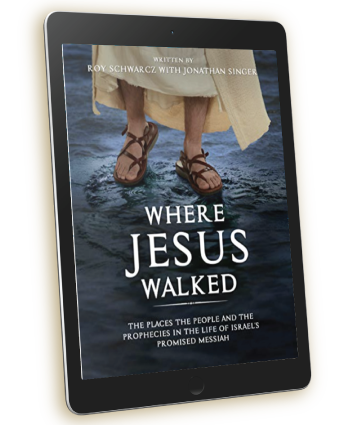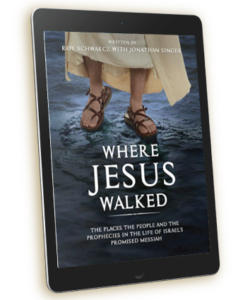Matthew 17:1-2. In Matthew 16:28 Jesus tells His disciples that some who were among them at that time would not die before seeing the Son of Man in His Kingdom. Peter made his confession of faith that Jesus was the Son of God in the region of Caesarea Philipi. Six days later Jesus takes Peter, James and Andrew to a high mountain where Jesus becomes transfigured before them. Where did this occur? In the fourth century, tradition had placed the location as Mount Tabor, which is between Nazareth and the Sea of Galilee. Archaeologists have discovered that there was a fortified city located at the top of Mt Tabor at the time of Jesus, making it most unlikely as the sight of the transfiguration.
Mount Hermon is snowcapped most of the year and located near Caesarea Phillipi where Peter made his confession of faith in Matthew 16. So it is likely that this was the location of the “high mountain”. The word transfiguration is an allusion to the radical change of appearance that came upon Jesus. For a brief period of time the glorious kingdom of God was unveiled before their eyes, and they saw that which Moses beheld (Exodus 33:18-24). God’s voice spoke from the midst of a bright cloud that surrounded them declaring that Jesus was His beloved Son.
Two of the foremost citizens of the Kingdom are present at that wonderful moment, Moses and Elijah. There was no doubt in the mind of Peter that the Kingdom of heaven had just been revealed. This is the reason he offers to build tabernacles. The Rabbis taught that the feast of Tabernacles would be the time that the Messiah would reveal himself and His glorious kingdom (Zech. 14). The Feast of Tabernacles commemorated the giving of thanks for the harvest. To remember God’s goodness in providing rains necessary for their plants to grow. Israel’s priests would lead those gathered in an elaborate ceremony in the Temple. Every day of Sukkot water and wine was poured into different silver tubes which emptied on the altar. On the 8th day, the Hoshanna rabba, the “great day” of this feast, the priests would lead a procession around the altar, while the Levites sang from the Psalms of Assents (Psalms 110-118). When they came to the words in the Psalm 118:26 Blessed is he who comes in the name of the Lord! We bless you from the house of the Lord, those that were of the remnant (true believers) would welcome the coming Messiah and King in their hearts, to whom these words they knew applied.
The Rabbis understood that this event was symbolic of two things: 1. The provision of water that God made for his children in the wilderness wanderings. 2. The promised pouring forth of God’s Spirit like waters upon the earth. It was probably at that moment that Jesus spoke the words quoted in John 7:37 Now on the last day, the great day of the feast, Jesus stood and cried out, saying, “If any man is thirsty, let him come to Me and drink. In John 7:39 we are told that Jesus was referring to the Spirit of God.
Tabernacles was the only feast that consisted of 8 days. In Scripture the 7th day speaks of rest, the rabbis believed that the 8th day spoke of resurrection. They believed that in God’s timetable Tabernacles speaks of the resurrection of the world spiritually. The duration of the world is six thousand years; two thousand of chaos, two thousand of law, and two thousand years of the coming of the Messiah (Yoma 97a). In my opinion this certainly reflects that the days we are in now as the days of Messiah. The seventh thousand is the millennium is when the world has a Sabbath a time when the Messiah will rule and reign on earth over the earth.
Matthew 17:3-9 – Some believe that Moses and Elijah appear on the Mt. because they represent two key aspects of the Older Covenant that was about to be fulfilled in Jesus. Moses brought the Law, and in many was a type of the Messiah. He learned humility on the backside of Midian just as Yeshua humbled himself (Phil. 2:8; Heb. 5:8). It was there that he “died” to his own plans and became the man God could use to represent His will to His chosen people. He was a type of prophet, priest and king. Elijah was the greatest of the prophets and their joint testimony on the mountain with Jesus compounded the Apostles impression of the magnitude of the moment. Complementing all of that was the voice of the Lord in the shekinah (glory) cloud and the impression was overwhelming. God had in OT times manifested Himself in the cloud Exodus 13:21, Numbers 9:17).
Matt 17:10-13 As they were coming down from the mountain, they ask Jesus questions. Having just seen Elijah, it likely motivated them to ask why Elijah was to come first. This was articulated through the prophet Malachi (Mal 3:1 & 4:5-6). Jesus had already shared that John the Baptist was Elijah who was to come (Matt. 11:14) and here repeats this truth. Just as the disciples were called to tell no one that He was the Messiah at Caesarea Philippi, so he tells the three to remain silent here. They would not understand what they experienced until after the cross and resurrection. But they have questions regarding Elijah. They ask “why … do the teachers of the law say that Elijah must come first?” The belief was that Elijah’s coming would place all things in order. Yeshua answers saying that Elijah had already come, and the Pharisees did not recognize him. Just as Elijah withstood the powers of his day and paid the penalty from the leaders of the Jewish people so too would the same fate come to the Son of Man. Like Elijah death would not have a hold on him, the Son of Man would be raised from the dead, and the transfiguration was a pledge of it. From the top of mountain, they returned to the other nine Apostles and to the multitude who they were ministering to. Peter, James, and John go from great glory on the mountain to the valley of failure.
Matt 17:14-20 Yeshua, Peter, James, and John came down from the mountain and find the other nine disciples in trouble (Mark 9:14-29; Luke 9:37-43). A child, severely afflicted with epilepsy caused by demon possession was brought to them. The boy’s father tells Jesus that his son is a lunatic. The expression “lunatic” means literally “moonstruck”. It was believed that the moon was the cause of these strange actions, Jesus identified the problem as demonic. In the account in Mark 9:18-26 the father said the demon seized the boy and threw him down to kill him, and that the boy had suffered this since he was small. The desperate father kneels before Jesus and pleads for His mercy. The disciples failed to cure the boy. Jesus’ rebuke in verse 17 was addressed generally to the unbelieving people of His day, but also to His disciples who failed to heal the young man. The boy was brought to Jesus, who cast out the demon and cured him immediately. The disciples asked Jesus why they could not cast out the demon. His reply was that their problem was their unbelief. In the Mark account we see it was the same problem the boy’s father had. Yeshua then makes the powerful statement on the power of faith in verses 19-21. Weakness of faith is a recurring problem. They and we tend to believe God when we are prosperous and comfortable but in crisis, we fail to trust God. Faith is like a mustard seed, small at first but then growing into something much larger and fruitful (Mat 13:32). The expression moving mountains referred to the ability to solve the hardest of tasks. The statement that nothing will be impossible is conditional to the will of God. Faith is not faith in oneself or even in the concept of faith but faith in God and His will and sovereignty over our lives. Lazarus is an example of this, even though he died, God’s will was for his resurrection and also for instructing His disciples of the power invested in Him. When Jesus said to the leper and to the man of Jericho that their faith had made them well, it meant faith in Jesus to heal not their own power of faith (Lk. 17:19; 18:42).
V 21 is not in the earliest translations and so it is marked in most Bibles. The Word of God, as most Biblical scholars believe, is in the original autographs or writings. Our Bibles today are a mirror of those original writings. Just as there is no perfect mirror that reflects our image, so too there is not perfect translation in any language.
22-23 – Once again Jesus tells His disciples that His betrayal and death are imminent. Their response is to be grieved. It would not be until after the resurrection that they would begin to understand what He was talking about. When He told them that He would be raised on the third day they probably thought that He was referring to the great resurrection of all those who died spoken by Daniel (Dan 12:2). This was Martha’s reaction in John 11:23-25.
V 24-27 The 2-drachma tax was the half shekel levy that God had instituted at the construction of the Tabernacle (Ex. 30:11-16). It was for the costs involved in maintaining the Tabernacle and later the Temple. The officials here were from the Temple, not from Rome. When asked if Jesus paid this tax Peter’s immediate response was yes. When Peter walks into the house Jesus asks him about the customs of the land regarding kings and if their sons were exempt. Peter is told that this is the case with Jesus. In fact, it was Jesus that this Temple was built to honor, and His Spirit that brought it glory. But instead of causing offense He submitted to the requirement of God’s Law and paid the tax. He humbled Himself taking on the form of a bond servant (Phil 2:7). Jesus instructs Peter to go to the Sea of Galilee, throw in his hook and the first fish will have a stater a coin in its mouth. A stater was the Greek coin equivalent in value to a shekel and with the coin Peter paid the tax for both himself and Jesus. Jesus paid the tax, and in like manner we are called to pay taxes. (Rom 13:1‑2, 5‑7) There are times when believers can stand opposed to a government’s decisions, but they must recognize that their authority is God ordained. Consider Peter and John’s response to the authority of the Sanhedrin in (Acts 4:19‑20). Like them when we stand against appointed authority, we need to be ready to suffer the consequences.


